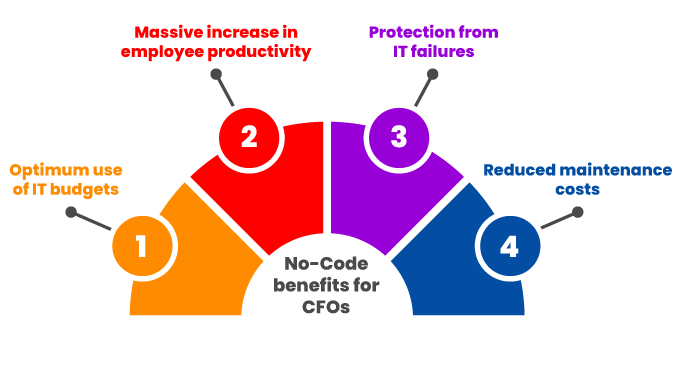
As a Chief Financial Officer (CFO), any executive’s primary aim is to manage the financial activities of an organization in a way that leads to maximum profitability. Every financial aspect of an organization, from the cash flows to investments comes under their scrutiny. These investments also include technology in it, as digital disruptors allow organizations to navigate the waters of today’s digital world.
Explore: Quixy for CEO
No-Code Benefits for CFOs
One such disruptor is no-code technology. A step ahead of traditional development, no-code allows for software development without writing a single line of code. No-code brings about a ton of improvement as far as digital transformation is concerned while being an economically fiscal choice for any organization. The financial advantages of adopting no-code are aplenty, as discussed below:

1. Optimum use of IT budgets
IT people have a lot of burden on them, as the digital demands of today are beyond what even the most competent IT departments can handle. From handling day-to-day solutions to creating complex applications, they are expected to deliver on multiple expectations within strict deadlines. As a result, often they are not able to do justice to the budgets allotted to them as they are overstretched.
This is where no-code is nothing short of a blessing. By enabling business users to build their own solutions, no-code reduces pressure on the IT department. As simple and daily-use applications are handled by business users, the IT people have the freedom to focus on projects of higher complexity and significance. This leads to the optimum utilization of IT budgets, allowing CFOs to make the most of the resources allocated.
2. Massive increase in employee productivity
As discussed above, no-code technology helps employees in becoming digitally dexterous. Instead of feeling intimidated by the influx of digital disruptors, they are empowered to use these disruptors to their benefit. Using simple and visual building blocks, business users can create solutions for the problems they understand best.
They are also able to do away with manual processes by digitizing them, leading to the elimination of grunt work and redundancies. Instead of using their precious time and peace of mind on thankless tasks, they can simply build solutions that do the work for them.
Hence, this not only leads to higher efficiency but a ton of qualitative benefits in terms of employee satisfaction. This allows employees to focus on the more fulfilling and challenging aspects of their job, providing them with a sense of achievement while boosting their morale. Engaged employees lead to higher productivity for an organization, which in turn leads to higher profits. As the effects are directly visible on the bottom line of the company, CFOs should seriously consider this aspect.

3. Protection from IT failures
Enterprise IT projects have been infamous for being very expensive while having a high chance of failure. In fact, McKinsey states that an average large-scale IT project ends up costing around 45% over the budget, shoots up the deadline by 7%, and yet provides only 56% of the planned value. This is evidently a major pain point for CFOs, and no code is a great way of working around this problem.
By doing away with the hassles associated with traditional coding, no-code technology ensures that the project is done within the stipulated time and budget. In fact, no-code is known to be 10 times faster than traditional development. No-code is super collaborative in nature too, preventing any silos or miscommunication. As revisions and improvements are easy to implement, repeated costs are saved as a result of the adoption of no-code. No-code technology wins hands-down against traditional development, and therefore, every CFO should make its adoption a priority.
4. Cost-Saving due to automation and reduced maintenance costs
As has been discussed above, no-code allows users to build automated workflows that eliminate paper-based and manual processes. Any manual process is prone to errors and delays due to its very nature, which can often translate to financial loss for the company. These processes are often time-taking and inefficient too, limiting companies in reaching their maximum potential.
Outdated legacy applications that are used by companies can lead to high costs and cause loss of time due to high maintenance requirements. This can reduce the productivity of the employees and drain the IT budget very quickly. If these legacy software are migrated to no-code tools, it will definitely be better for the IT budgets.
With no-code, these processes can be digitized and automated without a single line of code. This leads to a massive increase in speed and efficiency, which directly translates to better company performance and profitability. Any digital-first CFO should realize the importance of workflow automation and the benefits of adopting it through no-code technology.
Also read: Breaking down the benefits of No-Code for CEO, CIO, CISO, CFO, and Business Leaders
Takeaway
Drawing evidence from the points discussed above, it is very clear that no-code technology helps an organization in bringing down costs and making the most out of their investments, which is just what every CFO aims for. Therefore, this digital disruptor should be on the list of every CFO striving to increase profitability through digital transformation.
Quixy is a leading no-code platform that has enabled numerous organizations to bring about digital transformation and skyrocket profitability. Our award-winning platform has been used to implement several enterprise IT projects with impressive results.
So what are you waiting for? Don’t miss out on the chance to elevate your processes. Take the first step and get started with Quixy today.
Frequently Asked Questions(FAQs)
Q. How does No-Code impact financial efficiency?
No-Code improves financial efficiency by enabling streamlined automation of tasks, reducing manual processes, and facilitating quicker development and deployment of applications tailored to financial operations. This efficiency gain saves time and cost while enhancing accuracy and productivity within financial workflows.
Q. Can No-Code for CFOs contribute to cost savings and better ROI?
Yes, No-Code can contribute significantly to cost savings and better Return on Investment (ROI) by reducing development time and costs associated with traditional coding. It allows businesses to build and deploy applications faster, requires fewer resources, and enables quick adjustments or updates without extensive coding expertise. These factors collectively contribute to lower operational expenses and increased efficiency, thereby enhancing the overall ROI for businesses adopting No-Code solutions.
Q. What risk considerations are associated with No-Code for CFOs?
The risk considerations associated with No-Code for CFOs primarily revolve around data security, compliance, and potential limitations in customization. Security concerns may arise due to data access and integration with various systems. Compliance issues could emerge if the platform doesn’t meet regulatory standards or lacks proper controls.
Q. How does No-Code enable financial teams to adapt swiftly to changes?
No-Code empowers financial teams to swiftly adapt by offering easy-to-use tools that allow rapid creation and modification of applications. This agility permits teams to quickly adjust workflows, automate processes, and make necessary changes without extensive coding. With intuitive interfaces and simplified development, No-Code enables timely responses to evolving business requirements, ensuring financial operations remain flexible and responsive to changes.
Q. How can No-Code enhance financial processes for improved decision-making?
No-Code streamlines financial processes, automating tasks like data analysis and reporting. This enables quicker access to accurate information, aiding better and timely decision-making.
Login
Please login to comment
0 Comments
Oldest















